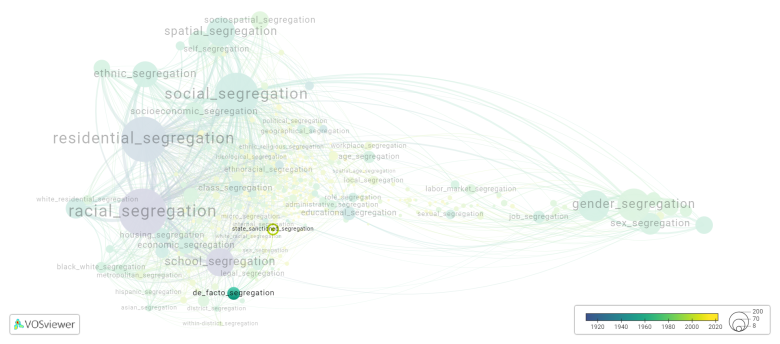State sanctioned segregation: Difference between revisions
(Creating page) |
(Creating page) |
||
| (12 intermediate revisions by the same user not shown) | |||
| Line 1: | Line 1: | ||
===== Date and country of first publication<ref>Date and country of first publication as informed by the Scopus database (December 2023).</ref>===== | |||
2009<br> | |||
United States | |||
===== Definition ===== | |||
State-sanctioned segregation refers to the legal separation of different racial, ethnic, or religious groups by the government. This type of segregation was prevalent in the United States until the mid-20th century, with laws and policies that enforced the separation of Black and white individuals in schools, public spaces, housing, and other areas of society. These laws were upheld by the government and enforced through various means, such as Jim Crow laws and the doctrine of "separate but equal." State-sanctioned segregation has had lasting negative effects on communities and individuals, contributing to inequality and discrimination. | State-sanctioned segregation refers to the legal separation of different racial, ethnic, or religious groups by the government. This type of segregation was prevalent in the United States until the mid-20th century, with laws and policies that enforced the separation of Black and white individuals in schools, public spaces, housing, and other areas of society. These laws were upheld by the government and enforced through various means, such as Jim Crow laws and the doctrine of "separate but equal." State-sanctioned segregation has had lasting negative effects on communities and individuals, contributing to inequality and discrimination. | ||
==See also== | ==See also== | ||
==Related segregation forms== | |||
State sanctioned segregation is frequently discussed in the literature with the following segregation forms: | |||
[[residential segregation]] | |||
[[File:state_sanctioned_segregation.png|780x780px]] | |||
This visualization is based on the study [[Segregation_Wiki:About| The Multidisciplinary Landscape of Segregation Research]]. | |||
For the complete network of interrelated segregation forms, please refer to: | |||
* [https://tinyurl.com/2235lkhw First year of publication] | |||
* [https://tinyurl.com/2d8wg5n3 Louvain clusters] | |||
* [https://tinyurl.com/223udk5r Betweenness centrality] | |||
* [https://tinyurl.com/244d8unz Disciplines in which segregation forms first emerged (Scopus database).] | |||
==References== | ==References== | ||
== | ==Notes== | ||
<references /> | |||
{{NoteAI}} | |||
==State sanctioned segregation appears in the following literature== | |||
Highsmith A.R. (2009). Demolition means progress: Urban renewal, local politics, and state sanctioned ghetto formation in Flint, Michigan. ''Journal of Urban History'', ''35''(3), 348-368. https://doi.org/10.1177/0096144208330403 | |||
Brilliant M. (2012). Blurring the color blind line eroding the dichotomy between color blindness and color consciousness in civil rights in the American story. ''Civil Rights in American Law, History, and Politics'', 113-137. Cambridge University Press.https://doi.org/10.1017/CBO9781139600170.004 | |||
Harris F.C., Lieberman R.C. (2013). Beyond discrimination: Racial inequality in a post racist era. ''Beyond Discrimination: Racial Inequality in a Post-Racist Era'', 1-362. Russell Sage Foundation.https://doi.org/ | |||
Cooke C., Stevenson A. (2018). Breaking boundaries, defying borders: transnational networks of gender and race in South Africa and the United States. ''Safundi'', ''19''(1), 1-8. Routledge.https://doi.org/10.1080/17533171.2018.1404739 | |||
Latest revision as of 07:17, 16 October 2024
Date and country of first publication[1][edit | edit source]
2009
United States
Definition[edit | edit source]
State-sanctioned segregation refers to the legal separation of different racial, ethnic, or religious groups by the government. This type of segregation was prevalent in the United States until the mid-20th century, with laws and policies that enforced the separation of Black and white individuals in schools, public spaces, housing, and other areas of society. These laws were upheld by the government and enforced through various means, such as Jim Crow laws and the doctrine of "separate but equal." State-sanctioned segregation has had lasting negative effects on communities and individuals, contributing to inequality and discrimination.
See also[edit | edit source]
Related segregation forms[edit | edit source]
State sanctioned segregation is frequently discussed in the literature with the following segregation forms:
This visualization is based on the study The Multidisciplinary Landscape of Segregation Research.
For the complete network of interrelated segregation forms, please refer to:
References[edit | edit source]
Notes[edit | edit source]
- ↑ Date and country of first publication as informed by the Scopus database (December 2023).
At its current state, this definition has been generated by a Large Language Model (LLM) so far without review by an independent researcher or a member of the curating team of segregation experts that keep the Segregation Wiki online. While we strive for accuracy, we cannot guarantee its reliability, completeness and timeliness. Please use this content with caution and verify information as needed. Also, feel free to improve on the definition as you see fit, including the use of references and other informational resources. We value your input in enhancing the quality and accuracy of the definitions of segregation forms collectively offered in the Segregation Wiki ©.
State sanctioned segregation appears in the following literature[edit | edit source]
Highsmith A.R. (2009). Demolition means progress: Urban renewal, local politics, and state sanctioned ghetto formation in Flint, Michigan. Journal of Urban History, 35(3), 348-368. https://doi.org/10.1177/0096144208330403
Brilliant M. (2012). Blurring the color blind line eroding the dichotomy between color blindness and color consciousness in civil rights in the American story. Civil Rights in American Law, History, and Politics, 113-137. Cambridge University Press.https://doi.org/10.1017/CBO9781139600170.004
Harris F.C., Lieberman R.C. (2013). Beyond discrimination: Racial inequality in a post racist era. Beyond Discrimination: Racial Inequality in a Post-Racist Era, 1-362. Russell Sage Foundation.https://doi.org/
Cooke C., Stevenson A. (2018). Breaking boundaries, defying borders: transnational networks of gender and race in South Africa and the United States. Safundi, 19(1), 1-8. Routledge.https://doi.org/10.1080/17533171.2018.1404739

